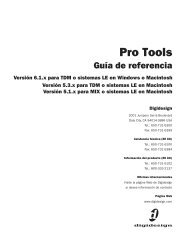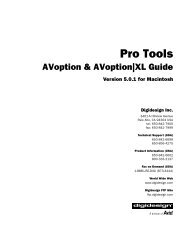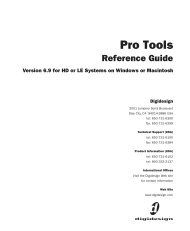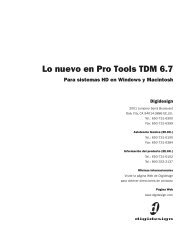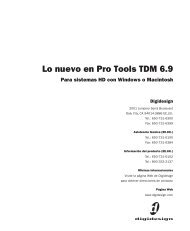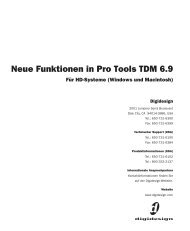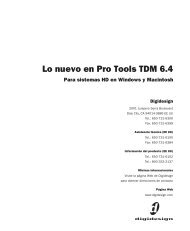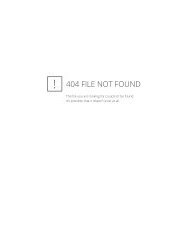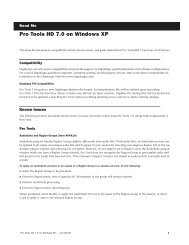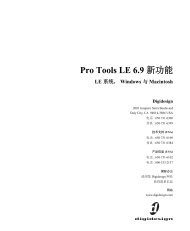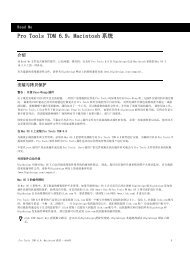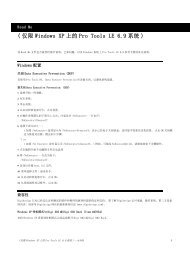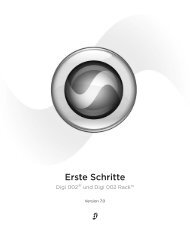5.1 DigiRack Plug-Ins Guide - Digidesign Support Archives
5.1 DigiRack Plug-Ins Guide - Digidesign Support Archives
5.1 DigiRack Plug-Ins Guide - Digidesign Support Archives
Create successful ePaper yourself
Turn your PDF publications into a flip-book with our unique Google optimized e-Paper software.
Feedback (FB) Controls the amount of feedback<br />
(positive or negative) applied from the output of<br />
the delay back into its input. This allows you to<br />
control the number of repetitions of the delayed<br />
signal.<br />
The pre/post switch selects whether the feedback<br />
signal is taken pre-mix (wet only) or postmix<br />
(actual output). Post-mix feedback is affected<br />
by the Mix control setting. To see a signal<br />
path diagram illustrating the effect of the<br />
pre/post switches, click on the Procrastinator<br />
logo; it will display the current signal flow. Click<br />
again to return to the logo.<br />
Low Pass Filter (LPF) Controls the cutoff frequency<br />
of the low-pass filter. This allows you to<br />
attenuate the high frequency content of the<br />
feedback signal. The lower the setting, the more<br />
high frequencies are attenuated. Moving the<br />
slider all the way to the right sets it to the off position.<br />
The pre/post switch determines whether<br />
the LPF is pre-feedback (affects the initial delayed<br />
repeat) or post-feedback (affects only the<br />
second and successive repeats).<br />
Tempo-Related Controls<br />
The remaining parameters of the Procrastinator<br />
plug-in provide you with an alternate method<br />
for entering a desired delay value. Rather than<br />
selecting a delay time, it allows you to set a<br />
tempo and the desired number of beats of delay.<br />
Tempo Selects the desired tempo in beats per<br />
minute (bpm). This setting is independent of<br />
Pro Tools’ tempo. When a specific Duration is<br />
selected (see “Duration” below) moving this<br />
control will affect the Delay setting and viceversa.<br />
Likewise, the range of both controls will<br />
be limited to the maximum available delay with<br />
the currently selected Duration. To enter very<br />
slow tempos or short delays it may be necessary<br />
to deselect all Duration buttons.<br />
Duration Specifies a desired delay from a musical<br />
perspective. Using the guideline of one beat is<br />
equal to one quarter note, enter the desired delay<br />
by selecting appropriate durations. You can<br />
enable multiple buttons by Shift-clicking them.<br />
Groove Provides fine adjustment of the delay in<br />
percentages of a sixteenth note. It can be used to<br />
add a groove by slightly offsetting the delay<br />
from the precise beat of the track.<br />
Dither<br />
The Dither plug-in is designed for improved<br />
16-, 18-, or 20-bit performance and reduced<br />
quantization noise when mixing or fading lowlevel<br />
audio signals.<br />
Dither plug-in<br />
Dither is a form of randomized noise used to<br />
minimize quantization errors in digital audio<br />
systems. Quantization distortion is most audible<br />
when the audio signal is near the low end of its<br />
dynamic range, such as during a quiet passage or<br />
fade-out.<br />
The introduction of dithering can reduce these<br />
quantizing errors with very low-level random<br />
noise, minimizing distortion products as audio<br />
reaches low level. With dithering there is a<br />
trade-off between signal-to-noise performance<br />
and less-apparent distortion. Proper use of dithering<br />
allows you to squeeze better subjective<br />
performance out of 16-bits (or whatever your<br />
destination bit-depth is).<br />
Chapter 4: <strong>DigiRack</strong> Real-Time TDM and RTAS <strong>Plug</strong>-<strong>Ins</strong> 37



